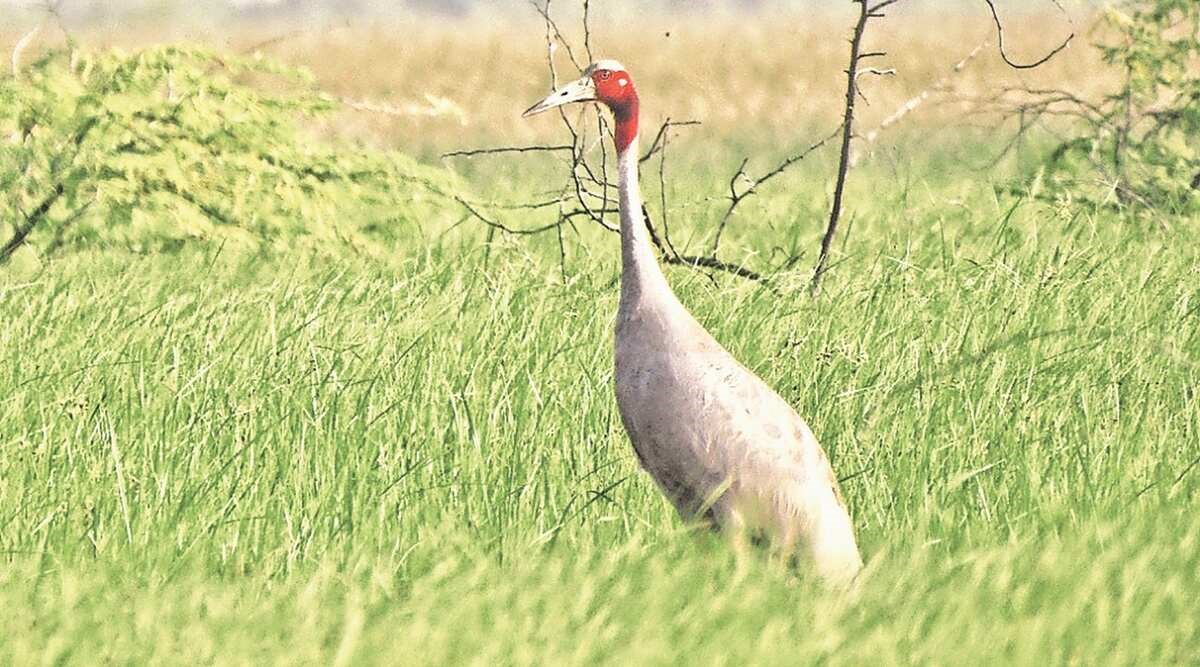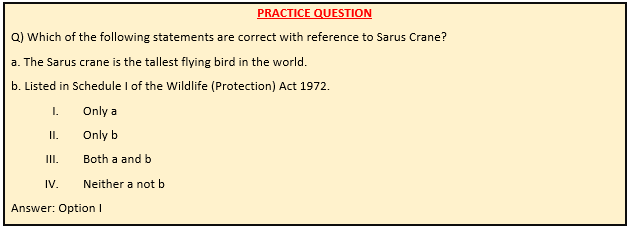Description

Copyright infringement not intended
Context: The population of Sarus Cranes (Grus antigone), which was on a decline in the 2000s in the wetlands of Matar Taluka in Kheda, has almost doubled over the past seven years with sustained and consistent efforts from the local villagers, conservationists and the district forest department.
Details:
- According to the latest data from the forest department, the count of the world’s tallest flying bird has increased by 98 per cent from around 500 in 2015 to nearly 992 in 2022 in the wetlands.
- Kheda and parts of the Anand district, which are close to the wetland, account for about 74 per cent of the state’s indigenous Sarus Crane population.
.jpeg)
About:
Key Facts
- Common Name: Sarus crane
- Scientific Name: Grus antigone
- Population: Estimated to be 15,000-20,000 individuals in India
- Height: 52-156 cm. Large, elegant crane
- Length: 90-130 cm
- Weight: 6.8-7.8 kg
- Status: Listed in Schedule IV of the Wildlife (Protection) Act 1972 and as Vulnerable on IUCN Red List
Characteristics:
- The Sarus crane is the tallest flying bird in the world.
- It has a predominantly grey plumage with a naked red head and upper neck and pale red legs.
- It is a social creature, found mostly in pairs or small groups of three or four.
- Known to mate for life with a single partner, its breeding season coincides with heavy rainfall in monsoon.
- Nests are constructed on water in natural wetlands or in flooded paddy fields.
- Usually a clutch has only one or two eggs, which are incubated by both parents for a period of 26 to 35 days. The juveniles follow their parents from the day of birth.
Conservation Issues:
- The main threat to the Sarus crane in India is habitat loss and degradation due to draining the wetland and conversion of land for agriculture.
- The landscape of its historic range is rapidly changing due to construction of highways, housing colonies, roads, and railway lines.
- More recently, many deaths have been recorded due to collision with power lines.
- Also, due to the increase in agricultural land, Sarus cranes are left with no choice but to forage in these fields, and as a result ingest pesticides, which lead to poisoning.

About Kheda:
- Kheda district of central Gujarat, situated in western India, occupies 719,400 ha area, and is located between two major rivers: Mahisagar on the eastern side and Vatrak, a tributary of River Sabarmati on the western side.
- The southern side is attached to the Gulf of Khambhat.
- The major area of the district has canal irrigation facility and therefore irrigated farming is practised.
- Paddy is extensively cultivated in Kheda district. As paddy fields are temporary wetlands, they provide an alternative to the natural marshland habitat of the Sarus Crane Grus antigone.


https://indianexpress.com/article/cities/ahmedabad/conservation-drive-pays-off-sarus-crane-count-nearly-doubles-in-kheda-wetland-in-7-years-8453193/






.jpeg)







